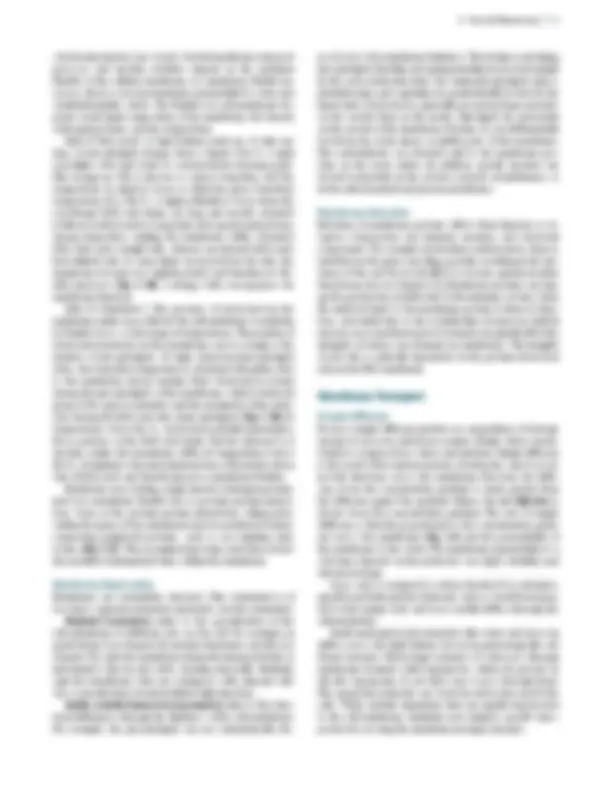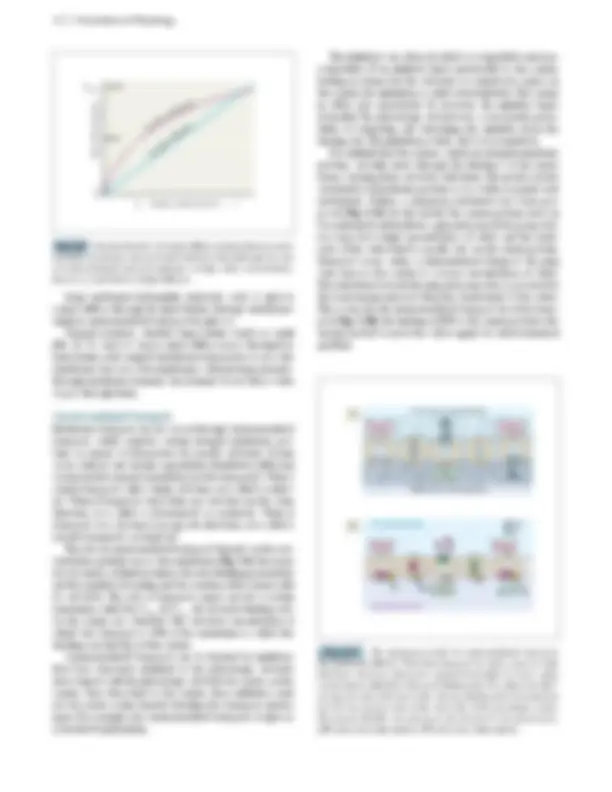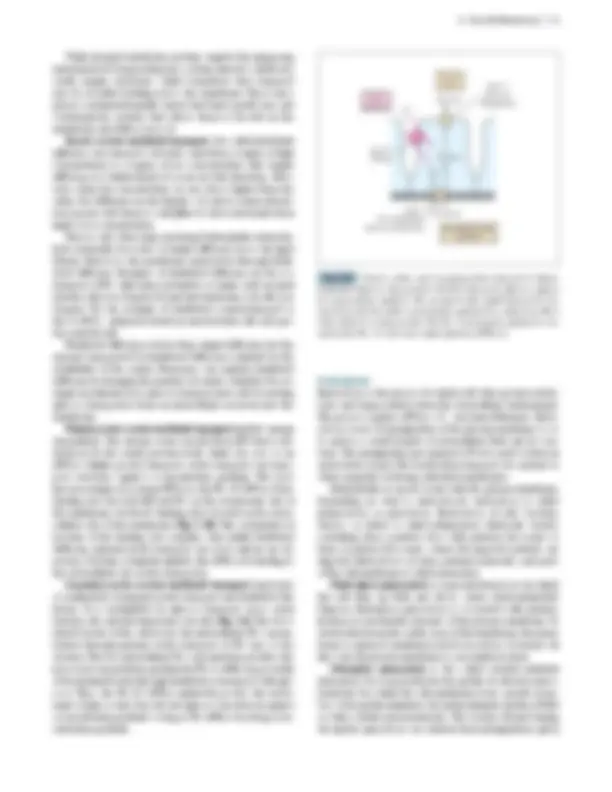






Study with the several resources on Docsity

Earn points by helping other students or get them with a premium plan


Prepare for your exams
Study with the several resources on Docsity

Earn points to download
Earn points by helping other students or get them with a premium plan
Community
Ask the community for help and clear up your study doubts
Discover the best universities in your country according to Docsity users
Free resources
Download our free guides on studying techniques, anxiety management strategies, and thesis advice from Docsity tutors
An in-depth exploration of the cell membrane, its composition, structure, and function. Topics covered include membrane phospholipids, proteins, the fluid mosaic model, membrane fluidity, membrane disorders, and membrane transport processes. The document also discusses the role of integral and peripheral proteins, the impact of temperature on membrane fluidity, and the various types of membrane channels.
Typology: Study notes
1 / 8

This page cannot be seen from the preview
Don't miss anything!





9
The cell’s organelles and its intracellular solutes (some inor ganic and some organic) are contained within the cell by its membrane. The membrane has limited and selective perme ability; it maintains the intracellular concentration of electro lytes and biologic compounds that is distinctly different from that of the extracellular fluid. Cell membrane function is thus an essential one for the health and survival of the cell.
Membranes are complex structures composed of lipids, pro teins, and carbohydrates. The cell membrane contains pro teins and lipids in a mass ratio of 50:50. An average membrane protein is several times larger than the average lipid molecule, but lipid molecules are ~50 times more numerous than pro tein molecules. The ratio is not absolute and varies from mem brane to membrane. The exact ratio between the two varies with the function of the cell. For example, the myelin sheath of nerves has ~75% lipids and 25% proteins, whereas membranes involved in energy transduction, such as the inner mitochon drial membrane, have 75% proteins and 25% lipids. The major membrane lipids are phospholipids, glycosphin golipids, and cholesterol. Membrane phospholipids are of two types: the phosphoglycerides ( Fig. 2.1A ), which are more abundant, and the sphingomyelins ( Fig. 2.1B ), which are prom inent in the myelin sheath. Glycosphingolipids present in the membrane include cerebrosides and gangliosides ( Figs. 2.1C and 2.1D ). Both are derivatives of sphingosine. Cholesterol is also present in the cell membrane, where it plays an important role in determining membrane fluidity (see below). The plasma membrane contains over 100 different pro teins: enzymes, transport proteins, structural proteins, anti gens (e.g., for histocompatibility), and receptors for various molecules. The external side of membrane proteins has oligo saccharide chains (carbohydrates) attached to them.
Membrane lipids are amphipathic; that is they contain both hydrophobic and hydrophilic regions. The hydrophilic (polar) region is their globular head; the hydrophobic (nonpolar) regions are their fatty acid tails. The membrane lipids are orga nized into a continuous bilayer (as seen in Fig. 2.2A ) in which the hydrophobic regions of the phospholipids are shielded from the aqueous environment, while the hydrophilic regions are immersed in water. Proteins are found inserted into this lipid bilayer and are classified into integral proteins and peripheral proteins. Integral proteins are anchored to membranes through a direct interaction with the lipid bilayer. Some of them span the entire thickness of the membrane, often traversing the mem brane several times ( Fig. 2.2B ). Others are located more on the outside or inside of the membrane. Integral proteins are amphipathic, consisting of two hydro philic ends separated by an intervening hydrophobic region that traverses the hydrophobic core of the bilayer. The hy drophilic ends of the integral protein are found outside the membrane, on either its external or internal surface. Integral A B C D Fig. 2.1 (A,B) Chemical structure of membrane phospholipids and (C,D) glycosphingolipids.
(^10) I I Foundations of Physiology proteins serve as (1) channels, which permit the passage of selected ions through the membrane; (2) carriers (or trans porters), which translocate substances across the membrane by binding to them; (3) pumps, which are carriers that split adenosine triphosphate (ATP) and use the energy derived for membrane transport of substrates; (4) receptors (located on the outside), which bind to specific molecules and generate a chemical signal initiating intracellular reactions; and (5) enzy- mes catalyzing reactions at the membrane surfaces, both outer and inner. Peripheral proteins do not interact directly with the phos pholipids in the bilayer. They are associated with integral pro teins via electrostatic interactions. They are located on both surfaces of the membrane. Peripheral proteins serve as cell adhesion molecules (CAMs) that anchor cells to neighboring cells and to the basal lamina. They also contribute to the cyto skeleton when present on the cytoplasmic side of the mem brane. For example, ankyrin, a peripheral protein located on the inside of the membrane, anchors spectrin (a cytoskeletal protein in the erythrocyte) to band3 (an integral protein of erythrocyte membrane). Ankyrin plays an important role in the maintenance of the biconcave shape of the erythrocyte ( Fig. 2.2C ).
The fluid mosaic model of membrane structure has been likened to icebergs (membrane proteins) floating in a sea of predominantly phospholipid molecules ( Fig. 2.3A ). Phospho lipids also float about in the plane of the membrane. This diffusion, termed translational diffusion , can be as rapid as A B C Fig. 2.2 Integral proteins. (A) Integral proteins with their polar resi- dues projecting out. (B) A molecule of G-protein spanning the mem- brane seven times, and a glucose transporter molecule, spanning the membrane 12 times. (C) A peripheral protein anchoring the integral protein to the cytoskeletal protein of an erythrocyte. Fig. 2.3 Membrane structure. (A) The cell membrane showing in- tegral and peripheral proteins. (B) Intercalation of kinked unsaturated fatty acid chains and cholesterol molecules spaces out the phospho- lipid molecules and affects membrane fluidity. (C) Antibody molecules cross-linking peripheral proteins. This reduces the mobility of integral proteins and reduces membrane fluidity.
(^12) I I Foundations of Physiology Large uncharged hydrophilic molecules such as glucose cannot diffuse through the lipid bilayer. Biologic membranes employ carriermediated transport for glucose. Charged particles, whether large (amino acids) or small (Na+, K+, Cl–, and Ca2+^ ions), cannot diffuse across the lipid bi layer. Amino acids employ membrane transporters to cross the membrane. Ions cross the membranes, often in large amounts, through membrane channels. Ion channels do not allow water to pass through them.
Membrane transport can also occur through carriermediated transport, which employs certain integral membrane pro teins as carriers or transporters for specific substrates. It may occur without any energy expenditure (facilitated diffusion) or may involve energy expenditure (active transport). When a carrier transports only a single substance, it is called a unipor- ter. When it transports more than one substance in the same direction, it is called a cotransporter or symporter. When it transports two substances in opposite directions, it is called a countertransporter or antiporter. The rate of carriermediated transport depends on the con centration gradient across the membrane ( Fig. 2.4 ), the num ber of carriers available (which is the ratelimiting parameter), and the rapidity of bonding and dissociation of the carrier with its substrate. The rate of transport cannot exceed a certain maximum, called the Vmax. At Vmax, all substratebinding sites on the carrier are saturated. The substrate concentration at which the transport is 50% of the maximum is called the binding constant (Km) of the carrier. Carriermediated transport can be blocked by inhibitors that bear structural similarity to the physiologic substrate and compete with the physiologic substrate for a place on the carrier. Once they bind to the carrier, these inhibitors may not dissociate easily, thereby blocking the transport mecha nism. For example, the carriermediated transport of glucose is blocked by phloridzin. The inhibitors are often classified as competitive and non competitive. If an inhibitor binds irreversibly to the carrier, leaving no chance for the substrate to compete for a place on the carrier, the inhibition is called noncompetitive. The carrier in effect gets inactivated. If, however, the inhibitor binds reversibly, the physiologic substrate has a reasonable proba bility of competing and dislodging the inhibitor from the binding site. The inhibition is then said to be competitive. It is unlikely that the carriers, which are integral membrane proteins, actually move through the thickness of the mem brane, carrying their substrate with them. The insideoutside asymmetry of membrane proteins is too stable to permit such movements. Rather, a ping-pong mechanism has been pro posed ( Fig. 2.5A ). In this model, the carrier protein exists in two principal conformations: ping and pong. In the pong state, it is exposed to high concentrations of solute, and the mole cules of the solute bind to specific sites on the carrier protein. Transport occurs when a conformational change to the ping state exposes the carrier to a lower concentration of solute. The transition between the ping and pong states is powered by the bond energy released when the carrier binds to the solute. This is true for all carriermediated transport. In active trans port ( Fig. 2.5B ), the binding of ATP to the carrier provides the energy needed to move the solute against its electrochemical gradient. Ping Pong Pong High solute concentration Low solute concentration K+ Na+ ATP (^) ADP (^) Ping Pong Pong Extracellular fluid Intracellular fluid A B Fig. 2.5 The ping-pong model of carrier-mediated transport. (A) Facilitated diffusion. Note that transport of solute occurs in both directions. However, transport is greater from higher to lower solute concentration. (B) Active transport. Binding sites for sodium ions (Na+) are present only at the inner side, whereas binding sites for potassium ions (K+) are present only at the outer side of the membrane carrier. This ensures that Na+^ can only move out, whereas K+^ can only move in. ADP, adenosine diphosphate; ATP, adenosine triphosphate. Fig. 2.4 Chemical kinetics of simple diffusion ( blue line ) and carrier- mediated membrane transport ( red line ). Note that although the rate of carrier-mediated transport plateaus at high solute concentration, there is no such limit to simple diffusion.
2 The Cell Membrane (^) I 13 While integral membrane proteins employ the pingpong mechanism for transporting ions, certain microbes synthesize small organic molecules called ionophores that transport ions by actually traveling across the membrane. These iono phores contain hydrophilic centers that bind specific ions and a hydrophobic exterior that allows them to dissolve in the membrane and diffuse across it. Passive carrier-mediated transport , also called facilitated diffusion , can transport substrates only from a region of high concentration to a region of low concentration. Like simple diffusion, it is bidirectional—it occurs in both directions. How ever, when the concentration on one side is higher than the other, the difference in the kinetics of solute–carrier interac tion ensures that there is a net flux of solute movement from high to low concentration. Glucose and other large uncharged hydrophilic molecules have extremely slow rates of simple diffusion across the lipid bilayer. They cross the membrane much faster through facili tated diffusion. Examples of facilitated diffusion are the co transport of Na+^ with monosaccharides or amino acids in renal tubular cells (see Chapter 55) and intestinal mucosal cells (see Chapter 70). An example of facilitated countertransport is the Cl–HCO 3 –^ antiporter found in renal tubular cells and gas tric parietal cells. Facilitated diffusion is faster than simple diffusion, but the amount transported by facilitated diffusion is limited by the availability of the carrier. Hormones can regulate facilitated diffusion by changing the number of carriers available. For ex ample, insulin increases glucose transport into cells by moving glucose transporters from an intracellular reservoir into the membrane. Primary-active carrier-mediated transport involves energy expenditure. The energy comes mostly from ATP that is hy drolyzed by the carrier protein itself, which also acts as an ATPase. Unlike passive transport, active transport can trans port substrates against a concentration gradient. The best known example of a carrier ATPase is the Na+–K+^ ATPase. It has binding sites for both ATP and Na+^ on the cytoplasmic side of the membrane, but the K+^ binding site is located on the extra cellular side of the membrane ( Fig. 2.5B ). This asymmetry of location of the binding sites explains why, unlike facilitated diffusion, primary active transport can occur only in one di rection. Ouabain or digitalis inhibits this ATPase by binding to the extracellular site on the transporter. Secondary-active carrier-mediated transport represents a combination of primary active transport and facilitated dif fusion. It is exemplified by glucose transport across renal tubular cells and intestinal mucosal cells ( Fig. 2.6 ). The baso lateral border of the cell lowers the intracellular Na+^ concen tration through primary active transport of Na+^ ions to the exterior. The low intracellular Na+^ concentration provides the necessary concentration gradient for Na+^ to diffuse in passively at the luminal border through facilitated cotransport with glu cose. Thus, the Na+–K+^ ATPase indirectly powers the move ment of glucose into the cell, and glucose can move in against a concentration gradient so long as Na+^ diffuses in along a con centration gradient.
Endocytosis is the process by which cells take up macromole cules and large particles from the extracellular environment. The process requires ATPase, Ca2+, and microfilaments. Endo cytosis occurs by invagination of the plasma membrane so as to enclose a small droplet of extracellular fluid and its con tents. The invagination gets pinched off at its neck to form an endocytotic vesicle. The vesicle then transports its contents to other organelles by fusing with their membranes. Alternatively, it can fuse back with the plasma membrane. Depending on what is endocytosed, endocytosis is called phagocytosis or pinocytosis. Endocytosis of cells, bacteria, viruses, or debris is called phagocytosis. Endocytic vesicles con taining these particles fuse with primary lysosomes to form secondary lysosomes, where the ingested particles are digested. Endocytosis of water, nutrient molecules, and parts of the cell membrane is called pinocytosis. Fluid-phase pinocytosis is a nonselective process in which the cell takes up fluid and all its solutes indiscriminately. Vigorous fluidphase pinocytosis is associated with interna lization of considerable amounts of the plasma membrane. To avoid reduction in the surface area of the membrane, the mem brane is replaced simultaneously by exocytosis of vesicles. In this way, the plasma membrane is constantly recycled. Absorptive pinocytosis is also called receptor-mediated pinocytosis. It is responsible for the uptake of selected macro molecules for which the cell membrane bears specific recep tors. Such uptake minimizes the indiscriminate uptake of fluid or other soluble macromolecules. The vesicles formed during absorptive pinocytosis are derived from invaginations (pits) K+ Na+ Glucose Glucose Glucose GLUT- (Glucose Transporter) SGLT- (Na+-dependent glucose transporter) Passive uniport Secondary-active symport Active antiport Na+^ –K+ ATPase Fig. 2.6 Passive, active, and secondary-active transport. Sodium- dependent glucose transporter-1 (SGLT-1) transports glucose against its concentration gradient. The energy for this uphill transport is de- rived from the favorable concentration gradient for sodium ion (Na+) with which it is cotransported. The Na+^ concentration gradient is cre- ated by the Na+^ –K+^ adenosine triphosphatase (ATPase).
2 The Cell Membrane (^) I 15 For passing completely through a channel, an ion has to ne gotiate two barriers: an outer pore and another pore called the selectivity filter located midway inside the channel ( Fig. 2.8 ). The ion enters the outer pore with its complete water of hy dration. Once it arrives at the inner selectivity filter, the ion sheds most of its water shell and forms a weak electrostatic bond with the polar (carboxyl) residues of the amino acids that line the channel wall. This electrostatic bond must release ade quate energy for stripping the ion of its water shell. The energy released is maximum when the unhydrated ion fits closely in the channel and is less if it floats loosely within the channel. The hydrated Na+^ ion is larger than the hydrated K+^ ion, and as would be expected, a Na+^ channel has a larger diameter than a K+^ channel. A hydrated Na+^ ion is a little too large to pass through the outer pore of a K+^ channel. The hydrated K+ ion is slightly less in diameter than the Na+^ channel, yet it is unable to pass through the Na+^ channel because the selec tivity filter of the Na+^ channel is oversized for a K+^ ion bereft of its water shell. Hence, the energy released due to the electro static attraction between the K+^ ion and the wall of the Na+ selectivity filter is inadequate for stripping the K+^ ion of its water shell. With its shell intact, the K+^ is unable to negotiate the selectivity filter of the Na+^ channel.
What makes channels unique as compared with other mecha nisms of membrane transport is that they can be gated (opened or closed) precisely. Depending on the factors that produce their opening and closing (gating), ion channels are classified into four types. Voltage-gated channels are gated by changes in mem brane potential. Examples are voltage gated Na+, K+, and Ca2+ channels. Ligand-gated channels are regulated by chemicals that bind to them (ligands). The ligand affects channel permeability in different ways ( Fig. 2.9 ). (1) It can bind to the receptor channel protein at an extracellular site (e.g., in acetylcholine receptors). (2) It can bind to the channel at an intracellular site (e.g., pro nase, local anesthetics). (3) It can bind to membrane receptors and activate a second messenger cascade, leading to phospho rylation of channel protein. Mechanically gated channels have pores that respond to mechanical stimuli like the stretch of the membrane. Resting channels are not gated at all. Resting channels make a substantial contribution to the membrane potential. Apart from these physiologic channels, membrane pores may be created in pathologic situations. Diphtheria toxin and activated serum complement components like the C5b C C7 C8 C9 fragment can produce large pores in cellular mem branes and thereby provide macromolecules with direct ac cess to the cell interior.
The cell membrane controls the movement of solutes into and out of the cell. The cell membrane is a lipid bilayer in which are embedded a large number of different proteins that serve different functions. A B C Fig. 2.8 The closest-fit theory of ion channel specificity. (A) A sodium ion (Na+) passes through the outer and inner pores. (B) A hydrated sodium ion is unable to pass through the outer pore of a potassium ion (K+)^ channel. (C) A hydrated K+^ is unable to pass through the inner pore. Fig. 2.9 Ligand-binding sites may be located on the outer mem- brane surface, or they may be present on the outer or inner parts of a membrane channel.
(^16) I I Foundations of Physiology Transport of solutes across the membrane occurs by four different processes: passive diffusion (down a gradient), carrier-mediated transport (also down a gradient), primary- active transport (against a gradient), and secondary-active transport (also against a gradient). Channels are membrane-spanning proteins (some always open, others gated by different stimuli) through which solutes can diffuse down a gradient.